What does sweet pea look like and how to grow it?

Sweet peas (the second name is rank) is a culture native to the Mediterranean, but Russian gardeners have long considered it theirs. Now there are more than 1000 varieties of this plant. In the article we will talk about the cultivation of culture, its varieties.
general description
Sweet peas are a liana-shaped culture. It is a tenacious plant that reaches a height of 3.5 meters. Inflorescences are similar to tassels. They contain up to seven flowers that look like small butterflies. There are a lot of shades, but there is never yellow during flowering. The fragrant rank emits a honey aroma during flowering. But each variety has its own smell. It is noteworthy that the varieties of this family are not inclined to overlap with each other.
The time of flowering falls on a long period: from June to the onset of the first cold weather. After the end of flowering, in place of wilted buds, beans of various shades with peas inside appear. Interestingly, seed germination lasts up to 8 years.
Initially, the culture pleased with its beauty only the inhabitants of the Mediterranean, but gradually it spread, and now it grows in almost all corners of the planet.


Types and varieties
The plant has a huge number of varieties, there are 10 main subgroups in total. The main differences between them are shape, color, height. Let's consider the most popular types of culture.
- Galaxy family - these are late-flowering varieties, the height of which reaches 2 meters. Inflorescences are corrugated, powerful, terry. The decorative flower is mainly used for cutting. Popular varieties in this group are "Neptune" and "Milky Way".
- The Spencer family includes multi-stemmed varieties with medium flowering. Double and wavy flower petals go well with other ornamental and climbing plants. The most memorable varieties are "Jumbo", "Charlotte".
- Family Cuthbertson Floribunda - This is a group of early flowering plants, the inflorescences of which consist of several corrugated flowers. Here varieties such as "White Pearl" and "Kenneth" stand out.
- The Lel family is considered an intermediate group., these are bushes up to one meter in height with powerful inflorescences. It is worth highlighting the varieties "Luciena" and "Lisette".
- The Rufled family it is distinguished by strong stems, powerful peduncles and a large number of inflorescences. It is worth noting the varieties "Grace" and "Ramona".
- Royal Family - heat-resistant plants with double flowers, which are very sensitive to lack of sunlight.
- Multiflora Gigantea - early flowering varieties up to 2.5 meters high. Used for cutting.
- Intergen - a dwarf group, which Russian breeders worked on breeding.
- Earle Spencer - early varieties with up to 4 flowers per inflorescence.
- Semi-dwarf late-flowering varieties up to 45 centimeters high. Most often they are used for decorating borders and ridges.
It is noteworthy that the perennial varieties have only pink or purple hues, and the annual varieties are painted in the entire color range. Therefore, gardeners most often use colored hybrids when planting in their beds.

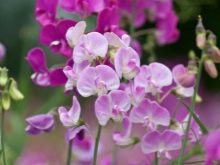
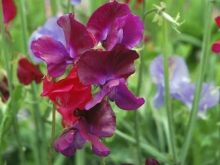
Landing
The middle of March is the time to sow the rank. The plant can be cultivated with both seeds and seedlings.
Seedlings
As for planting peas for seedlings, the seeds are sown 6 weeks before the planned planting in the ground. Seed material has poor germination, so gardeners use preparation. To do this, the contents of the sachet are sent to the "Bud" agent heated to a temperature of 50 degrees for half a day. Then they are placed for germination for three days in moistened sand at a temperature of +24 degrees. After the first shoots have appeared, the seeds can be planted in a ready-made soil from peat, humus and sod land in proportions of 2: 2: 1. It is recommended to treat the soil with a weak solution of manganese.
Ready sprouts of 2-3 pieces are best planted in cups with moistened soil, deepening them by 20 millimeters. When planting in a large container, it is recommended to maintain a distance between the shoots of at least 80 millimeters. Then the containers should be covered with plastic and sent to a warm place.
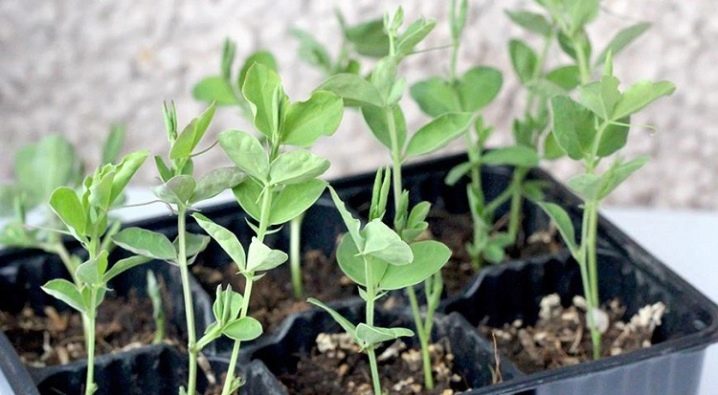
Seedlings will appear no earlier than two weeks later. After that, the shelter is removed from the containers, slightly moistened and sent to a place where the temperature does not exceed +17 degrees. If you want the peas to be particularly splendid, then slightly pinch the top above the third leaf. The polka dots will feel best on the windowsills on the south side. If the weather outside the window is more often cloudy, then it is recommended to turn on a phytolamp for the plant. It is necessary to ensure that the soil is always moist, not overdried. The optimal watering frequency is considered once a week. It is not recommended to pick the rank, its root system does not like any interventions. The Kemira complex is best suited as a mineral fertilizer. Such care will be especially beneficial on poor soils.
If the culture has grown up to 10 centimeters in height, then it is already possible to transplant to a permanent place. It is best to move the seedlings together with a clod of earth. Until that moment, it is recommended to calcify the soil for planting. When the soil is completely warmed up (and this will not be until the second half of May), it will be possible to transplant. If suddenly the plant already has buds or flowers, then they need to be plucked. The sprouts are planted at a distance of 30 centimeters; there should already be supports near the holes. The next planting of peas in the same place should take place no earlier than in 5 years.
For the first week, it is recommended to install a small awning over the seedlings to protect from the sun's rays.
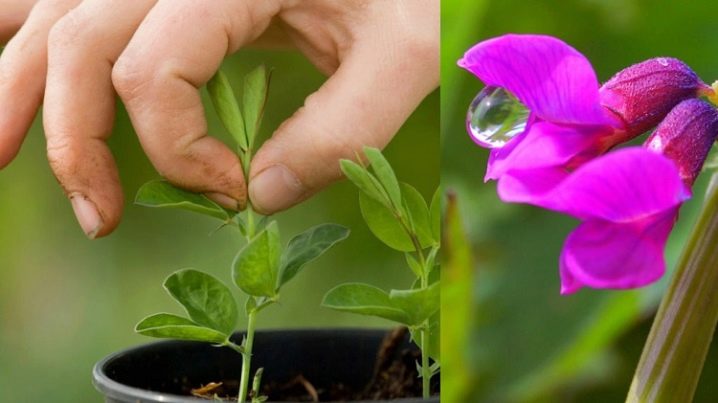
Seeds
Sometimes peas are planted as seeds directly into the ground. This is convenient because some species are perennials. Sowing work can be carried out in May. Seeds are determined in holes at a distance of 10 centimeters from each other, and the planting depth varies from 3 to 4 centimeters. The hole must first be watered, and then three peas must be placed in it. Immediately you need to install the supports. After germination, if desired, the seedlings are thinned out. An obligatory rule for caring for spring seedlings is constant watering of the ranks.
Some gardeners practice sub-winter planting. After all, young shoots are resistant to spring cold, and flowering is richer than that of spring plantings. Two weeks before the onset of cold weather, the garden bed is dug, loosened, cleaned of plant debris. As soon as the first frosts come, you can dig furrows up to five centimeters deep, and the seeds are sent there. Everyone is covered with earth, mulched or covered with spunbond until spring.
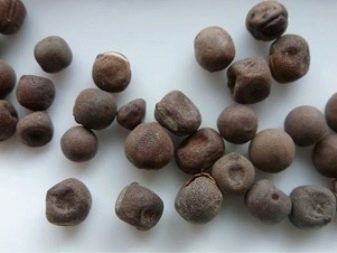
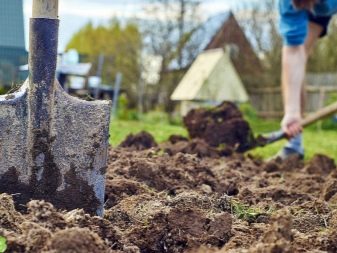
Growing care
Caring for a plant on the balcony and in the open field is almost identical, because this culture is unassuming. It is not difficult to grow a culture in the country in a season, and if it is planned to plant perennial varieties, then the plant will delight with its flowering for many years. Standard agricultural techniques include optimal watering and maintaining the desired temperature, keeping from bright sunlight.
For abundant flowering, peas require good watering.If the ground underneath dries up, then the plant does not form flowers and buds. The approximate consumption per square meter is up to 3.5 buckets of water. Bushes planted for seed should be watered a little less often. China does well without fertilizers, but gardeners say that it is still possible to feed it. At the time of emergence, use Agricola or potassium sulfate, and at the time of bud formation, use Agricola or Dew.
Stimulating the adventitious shoots, it is recommended to spud greens to a height of 50 millimeters, and to scoop up nutritious soil to the base of the stem. This is a climbing plant, therefore, in a garden on a flower bed, it is best to immediately plan the installation of supports or plant a rank next to a wall that the peas could cling to. Fast-growing stems are recommended to be constantly directed in the right direction.
The flower culture does not need pruning. The only thing that needs to be done constantly is to remove faded flowers. You can plant seedlings in outdoor pots and pots, hanging on a support.

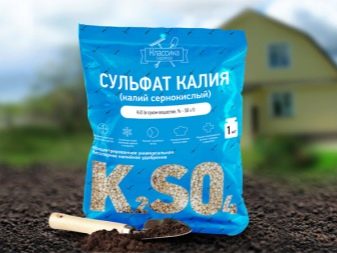
The stems will subside as they grow, forming an original composition. Before wintering, perennial varieties are deprived of supports, and all excess shoots are cut off. A flowerbed with plantings is mulched with sawdust and humus. If it was an annual, then the site is simply cleared of vegetation.
After the rank has faded, a pod is formed in it, it grows quickly, and inside it there are several peas. When the pod turns light brown, it means that it is ripe. To collect seed, the pods are recommended to be cut and dried, and then opened. Further, the peas must also be sent for drying for 2-3 days, and then packaged in packages. You can store it for up to 8 years.
To carry out successful agricultural technology, gardeners recommend using some tips:
- during flowering, the aroma will be stronger if the rank is planted on a small elevation;
- after the appearance of the first leaf blades, it is recommended to start thinning the plant up to a distance of 15 centimeters;
- before sowing, the pea is slightly kneaded to accelerate germination;
- when applying fertilizers, it is necessary to alternate organic matter with mineral additives.
It is best to sow the crop with seeds before winter. So the plant will be distinguished by lush greenery, abundant flowering. With spring sowing, the plant will bloom later. If planted through seedlings, then the culture will have long stems, which, when transplanted, break easily and do not take root well.
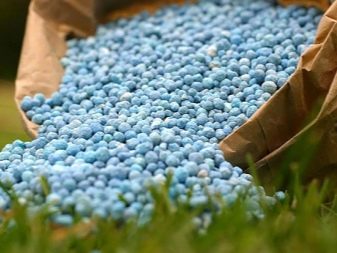

Diseases and pests
The plant has a sufficient number of pests, therefore, at the slightest suspicion, it is necessary to start a fight with them.
- The nodule weevil gnaws through the leaf plates, and its larvae harm the root system. As a preventive measure, a little "Chlorophos" is thrown into the holes, and then greens are treated with it.
- Aphids feed on the sap of the plant, provoking wilting of the bushes. For its removal it is worth using "Tsiram", "Tsineb".
Among the diseases, the following ailments cause the greatest harm.
- If brown blotches appear on the leaf plates, then this is ascochitis. It is worth treating with "Rogor" (twice with an interval of two weeks).
- If the plant is affected by fusarium, then nothing will help it, so it is worth collecting all the greens and burning it.
- Powdery mildew and downy mildew appear in July as a whitish bloom. With such an ailment, only colloidal sulfur can help.
- If line art appears on the leaves and stems, then this is a viral mosaic. The plant is also harvested and destroyed.
- If the culture has begun to darken, then it is most likely root rot. In this case, China will die.
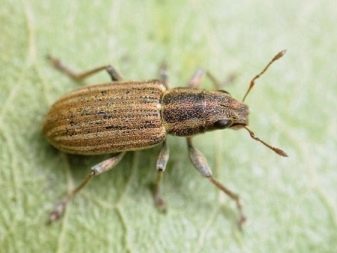
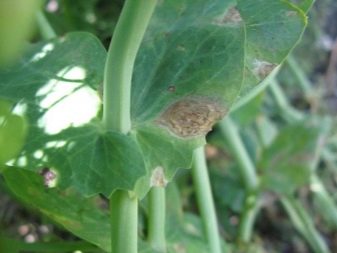
Application in landscape design
Chyna looks beautiful on any site. The decorativeness and aromas are always at their best. Each variety has its own advantages. It is convenient to plant dwarf varieties in rabatki, near curbs, in small flowerpots, to decorate rock gardens with them. The plant looks good on hills.Tall, powerful varieties are convenient to cultivate as vertical gardening, when forming a background, when decorating various elements.
Medium-sized bushes go well for cutting. Peas are planted in hanging pots and flowerpots, decorating terraces, verandas and balconies. Due to the unpretentiousness of the rank, it will delight gardeners until the first frost. Every year more and more varieties appear, so anyone can choose a plant for their site or balcony.
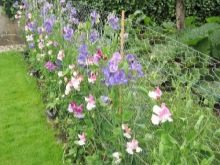
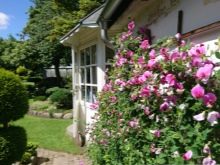
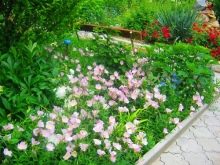







































































































The comment was sent successfully.